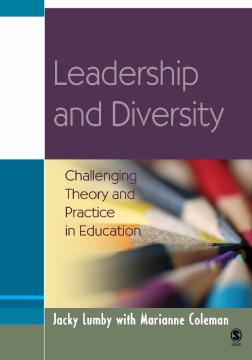
Additional Information
Book Details
Abstract
What do we mean by diversity? Why is it an important issue for leaders of schools, colleges and universities? As society becomes increasingly diverse, there is significant international awareness in education about how this impacts on leaders and leadership. For decades the emphasis has been placed on increasing the number of leaders with specific attributes, such as women or those from ethnic minorities, to encourage a true representation of society. This far-reaching book takes a wider view, challenging the reader to recognize the importance of diversity issues and to embed diversity as central within leadership theory and practice. Drawing on their extensive research; the authors establish a clear understanding of what diversity means and use this to develop a distinct approach to conceiving leadership, preparing leaders and acting as leaders. They explain how diversity should be an holistic issue which touches every aspect of leadership and is vital to ensuring effective and appropriate leadership for education in pluralist societies. The authors explore the history of approaches to addressing inequities in access to leadership positions and the experience of leadership, from equal opportunities, to diversity and inclusion, to capabilities approaches. The book also proposes fundamental and concrete changes that leaders can undertake both in their own and their organization's practice, to reflect a real commitment to social justice in a diverse society.
Table of Contents
| Section Title | Page | Action | Price |
|---|---|---|---|
| FOREWORD BY THE EXECUTIVE DIRECTOR OF UNEP, KLAUS TOPFER | |||
| NOTE FROM THE EXECUTIVE EDITOR OF THE GBA, VERNON HEYWOOD | |||
| ACKNOWLEDGEMENTS | |||
| CONTRIBUTORS | |||
| PREFACE BY DARRELL ADDISON POSEY | |||
| LIST OF COLOUR PLATES | |||
| CHAPTER 1 | |||
| INTRODUCTION: CULTURE AND NATURE - THE INEXTRICABLE LINK | |||
| DARRELL ADDISON POSEY | |||
| CHAPTER 2 | |||
| UNGUISTIC DIVERSITY | |||
| LUISA MAFFI | |||
| CHAPTER 3 | |||
| INDIGENOUS PEOPLES, THEIR ENVIRONMENTS AND TERRITORIES | |||
| ANDREW GRAY | |||
| CHAPTER 4 | |||
| VOICES OF THE EARTH | |||
| RANIL SENANAYAKE | |||
| CHAPTER 5 | |||
| ETHNOSCIENCE, 'TEK' AND ITS APPLICATION TO CONSERVATION | |||
| L. JAN SUKKERVEER | |||
| CHAPTER 6 | |||
| VALUING BIODIVERSITY FOR HUMAN HEALTH AND WELL ·BEING: | |||
| TRADITIONAL HEALTH SYSTEMS | |||
| GERARD BODEKER | |||
| CHAPTER 7 | |||
| TRADITIONAL AGRICULTURE AND SOIL MANAGEMENT | |||
| KRISTINA PLENDERLEITH | |||
| CHAPTER 8 | |||
| MOUNTAINS: THE HEIGHTS OF BIODIVERSITY | |||
| CHAPTER 9 | |||
| FORESTS, CULTURE AND CONSERVATION | |||
| SARAH A. LAIRD | |||
| CHAPTER 10 | |||
| AQUATIC AND MARINE BIODIVERSITY | |||
| PAUL CHAMBERS | |||
| CHAPTER 11 | |||
| ETHICAL, MORAL AND RELIGIOUS CONCERNS | |||
| CHAPTER 12 | |||
| RIGHTS, RESOURCES AND RESPONSES | |||
| GRAHAM OUTFIELD | |||
| CONCLUSION | |||
| MAINTAINING THE MOSAIC | |||
| DARRELL ADDISON POSEY | |||
| APPENDICES | |||
| 1 . DECLARATIONS OF THE INDIGENOUS PEOPLES' ORGANIZATIONS | |||
| 2. FAITH STATEMENTS ON RELIGION AND ECOLOGY | |||
| 3. PARTICIPANTS IN THE PEER REVIEW PROCESS | |||
| 4. THE CONTRIBUTORS | |||
| 5. ABBREVIATIONS ANO ACRONYMS | |||
| BIBLIOGRAPHY | |||
| INDEX |
